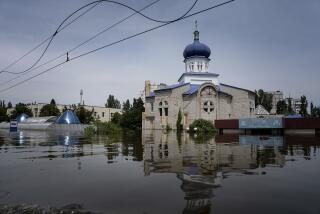Environmental Destruction in Kashmir : Overpopulation Turns Lake Into Sewer
- Share via
SRINAGAR, India — The water laps gently against the side of punt-like boats as they glide over the shadow-dappled waters. The sunset plays against the trees lining the far shore and the mountains rising above, still snowcapped despite the summer’s heat.
Children laugh. Fathers smile as mothers lean back against boat cushions, enjoying a respite from the oven that is the Indian plains in summer.
Kashmir and the fabled lakes of its capital, Srinagar, have been a lure for centuries. Mogul princes praised the serene waters and majestic mountains here. British merchant princes and the generals who built the empire also came. Forbidden from owning land by the maharajah, they built houseboats that were like floating castles on the lakes.
“In 1922 I used to visit my customers in a boat,” said Mohammad, a Kashmiri resident and a craftsman of delicately painted papier-mache objects. “It was so beautiful, so clear. I could see right to the bottom.
“In the old days, when Dal Lake was really a lake--no motorboats, no swimming boats, no pollution--when there was just you and a small boat and privacy, people used to bring their friends with a small kitchen boat to serve,” Mohammad recalled. “The singers would come to sing the praises of the beauty of the lake and the gardens, and, oh, the people were just carried away. Their heads would sway with the music, and they would draw happily on their hookahs.”
It takes the memory and sensitivity of such a master artisan to shake the reverie of contemporary visitors to Kashmir’s lakes, to remind people that today’s beauties pale beside those of just a few decades ago, to warn that what once was is rapidly disappearing.
Dal Lake is vanishing, its shoreline shrinking with the ravages of overpopulation and careless abuse of Kashmir’s abundant natural beauty. Weeds choke its bottom.
“Within living memory, open water in the lake is down from 14 square miles to nine square miles,” said an expert who has studied Kashmir’s lakes.
He said tons of silt flow annually into the lake from denuded hillsides that straddle feeder streams. The refuse of 1,400 houseboats attacks the lake’s ecological balance, but this is only a small villain compared to the 25 million gallons of raw sewage that are believed to flow into the waters daily.
In 1961 Srinagar had a population of 285,000. By 1987, it was 850,000. The refuse of the trebled numbers is choking the lake that gives them economic sustenance.
The fate of Kashmir and its lakes is a microcosm of what is happening in much of the rest of India as a population that is expected to reach 1 billion by the year 2000 takes its toll on the finite resources of the country.
India is replete with stories of environmental destruction. Vast forests have disappeared within a space of one or two generations. Waters that once were pure now are cesspools. Deserts have spread as the grasses and trees that once held them in check are cut away.
“In my area of eastern Uttar Pradesh, near the Himalayan foothills, there used to be great forests, but the timber mafia is taking it all away,” a prominent politician said recently. “Nobody can challenge them. Police have old World War II rifles. They have modern weapons. Who can challenge them?”
Here and there, villagers or environmentalists band together to try to save a forest or a river. Occasionally an honest government official will resist the proffered bribes, and often the accompanying threats, to enforce laws protecting woodlands.
For the most part, however, the destruction goes on unchecked. The Kashmirian government, worried that the lake that brings in so many tourists may be dying, is trying to encourage help from New Delhi and international aid to do something about the situation.
Answers seem simple. More sewer systems and proper water supplies are needed here, as in much of India’s burgeoning urban areas. But building sewers and laying water lines in congested lanes amid haphazardly constructed buildings are either impossible or enormously expensive. Governments wrangle over who will foot the bill.
More to Read
Sign up for Essential California
The most important California stories and recommendations in your inbox every morning.
You may occasionally receive promotional content from the Los Angeles Times.










